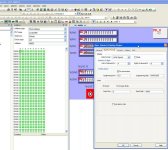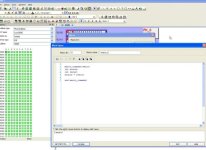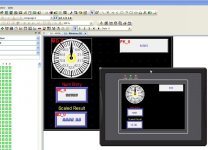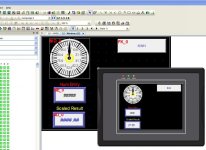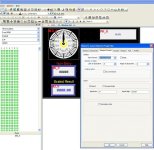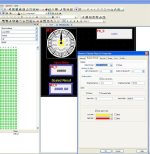I'm making great progress replacing a panel of buttons with a wiz-bang HMI.
But with so many "features" in the HMI, it is only natural to want more.
At present I am working with Data Display for 12 Analog input channels. 8 ch of 0-10V and 4 ch of 0-20ma. These take care of monitoring the various stand alone devices associated with a vacuum coating tool. (vis. pressure, temperature, amps and volts)
Display pages have been made for trend, both History and Real Time, Data displays, numeric displays and numeric inputs, bar graphs and meters. All well and good,
Except for resolution! and the lousy decimal point.
Presently I am using the math functions within the plc logic, (-32768 to 32767 or 0 to 32767 divide by 33, move to %Rnnnn etc., giving up much desired precision in the division of a non float) and then displaying the data without decimal points. Text object Legends are added to the graphics to cover the deficit. I feel this may become confusing to the uninformed observer. (The Numeric display scaling function goes a long way towards making everything obvious, but the trends and meter displays can be confused.)
What is wanted is to take the 16 bit signed or unsigned data from the plc (GE 90/30 without FP) move it into the HMI and then perform a conversion to FP format. Store this converted data in a HMI internal memory location (LWnnnn) and then use the data value in multiple graphical displays. A typical page would include a trend graph, a meter and a numeric display for any one, or a combination of several analog inputs.
I've been advised that the conversion from 16 bit signed/ unsigned to FP is best done with a macro.
I've looked through the several hundred pages of macro instructions more than once, but don't seem to be able to "translate" the helps and directions. (Painfully aware of my "programmers" ineptitude).
Perhaps it is just the "writing style" of the mfg, macro instructions. Of , just me.
A couple of things stop me before I start.
If I use the "Get Data" instruction, How is this implemented in real time displays? The macro instructions suggest all macros need triggers, with no mention of time base.
If there is not a "canned instruction" to convert a signed integer to FD, what macro instructions do the job ?
Are macro instructions "common"? Or unique to each panel mfg.?
That is, can I learn from "generic" macro tutorials?
Finally, and to my post header. Are there such macro references?
I am capable of learning, but when the definition uses the same term as my question, I fall apart ;-)
note harware:
PLC= GE 90/30 311 with 3 ea. 4 channel Analog cards
HMI Wientek 8070h Connected via Horner HE693SNP900 interface card
EB8000 and LM90 software
If you read this far, Thanks!
Comments appreciated
Cal
But with so many "features" in the HMI, it is only natural to want more.
At present I am working with Data Display for 12 Analog input channels. 8 ch of 0-10V and 4 ch of 0-20ma. These take care of monitoring the various stand alone devices associated with a vacuum coating tool. (vis. pressure, temperature, amps and volts)
Display pages have been made for trend, both History and Real Time, Data displays, numeric displays and numeric inputs, bar graphs and meters. All well and good,
Except for resolution! and the lousy decimal point.
Presently I am using the math functions within the plc logic, (-32768 to 32767 or 0 to 32767 divide by 33, move to %Rnnnn etc., giving up much desired precision in the division of a non float) and then displaying the data without decimal points. Text object Legends are added to the graphics to cover the deficit. I feel this may become confusing to the uninformed observer. (The Numeric display scaling function goes a long way towards making everything obvious, but the trends and meter displays can be confused.)
What is wanted is to take the 16 bit signed or unsigned data from the plc (GE 90/30 without FP) move it into the HMI and then perform a conversion to FP format. Store this converted data in a HMI internal memory location (LWnnnn) and then use the data value in multiple graphical displays. A typical page would include a trend graph, a meter and a numeric display for any one, or a combination of several analog inputs.
I've been advised that the conversion from 16 bit signed/ unsigned to FP is best done with a macro.
I've looked through the several hundred pages of macro instructions more than once, but don't seem to be able to "translate" the helps and directions. (Painfully aware of my "programmers" ineptitude).
Perhaps it is just the "writing style" of the mfg, macro instructions. Of , just me.
A couple of things stop me before I start.
If I use the "Get Data" instruction, How is this implemented in real time displays? The macro instructions suggest all macros need triggers, with no mention of time base.
If there is not a "canned instruction" to convert a signed integer to FD, what macro instructions do the job ?
Are macro instructions "common"? Or unique to each panel mfg.?
That is, can I learn from "generic" macro tutorials?
Finally, and to my post header. Are there such macro references?
I am capable of learning, but when the definition uses the same term as my question, I fall apart ;-)
note harware:
PLC= GE 90/30 311 with 3 ea. 4 channel Analog cards
HMI Wientek 8070h Connected via Horner HE693SNP900 interface card
EB8000 and LM90 software
If you read this far, Thanks!
Comments appreciated
Cal




